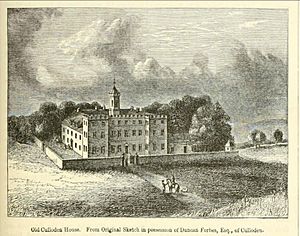John Forbes (died 1734) facts for kids
John Forbes (around 1673–1734) was an important Scottish politician. He came from Culloden, a place in Inverness, Scotland. John Forbes served in the Parliament of Scotland from 1704 to 1707. After Scotland and England joined to form Great Britain, he then served in the British House of Commons from 1713 to 1727.
Contents
Who Was John Forbes?
John Forbes was the oldest son of Duncan Forbes, who was also a Shire Commissioner. His mother was Mary Innes. John went to school at Inverness Royal Academy. He also had private lessons in Edinburgh in 1692. Later, he traveled to the Low Countries (which include modern-day Belgium and the Netherlands) for about a year. In June 1699, he married Jean Gordon. He also served as a Commissioner for justice in the Highlands in 1701 and 1702.
Starting in Politics
In 1704, John Forbes took over the Culloden estate after his father passed away. He also became a Shire Commissioner for Nairnshire in the Scottish Parliament.
In the Scottish Parliament
John Forbes quickly joined the group that opposed the government. He stayed with the Country party, especially when it came to the idea of the Union between Scotland and England. He believed the Union would lead to "inevitable ruin" for both the Church and the state. He voted against many government proposals in the Scottish Parliament. He was also concerned about how the Union might affect certain financial arrangements he had.
Joining the British Parliament
John Forbes wanted to gain more political influence. He aimed for a seat in the British House of Commons. He did not run in the 1708 or 1710 elections. However, in the 1713 British general election, he was elected as a Whig Member of Parliament for Nairnshire. This was the same area he had represented before the Union. He formed a connection with the Duke of Argyll and began his work in Parliament. He was in Edinburgh when King George was proclaimed king and supported the new monarch.
A Time of Rebellion
John Forbes worked hard for the Whig party in the 1715 British general election. He was elected as an MP for Inverness-shire. During the 1715 Jacobite rebellion, he helped defend the northern parts of Scotland. He believed that the rebels should not be treated too harshly, especially regarding their property being taken away. He spent about £3,000 helping the Crown. He was partly paid back with a job as a Commissioner of the Equivalent, earning £500 a year from 1716.
Public Service Roles
In 1716, John Forbes also held several other public roles. He was a Commissioner overseeing elections in Elgin. He became a Councillor of Inverness and served as Provost of Inverness until 1717. He also visited Aberdeen University as a visitor from 1716 to 1717. Along with his brother, Duncan, he became close to the Duke of Argyll. He voted against the government in 1717 to support Argyll. Even though he lost his job as Commissioner of the Equivalent, he voted with the government in 1719 when Argyll returned to power. He was Provost of Inverness again in 1721.
Later Political Years
In the 1722 British general election, John Forbes lost his seat in Inverness-shire. However, he was once again elected for Nairnshire. In the 1727 British general election, Nairnshire did not have a representative, and he was defeated in Inverness-shire. He tried to run for Inverness-shire again in 1734, but he was very ill at the time.
Legacy and Passing
John Forbes passed away in Edinburgh on December 18, 1734. He had one son who survived him, but his other children had passed away earlier. His brother, Duncan, inherited the family estate.


